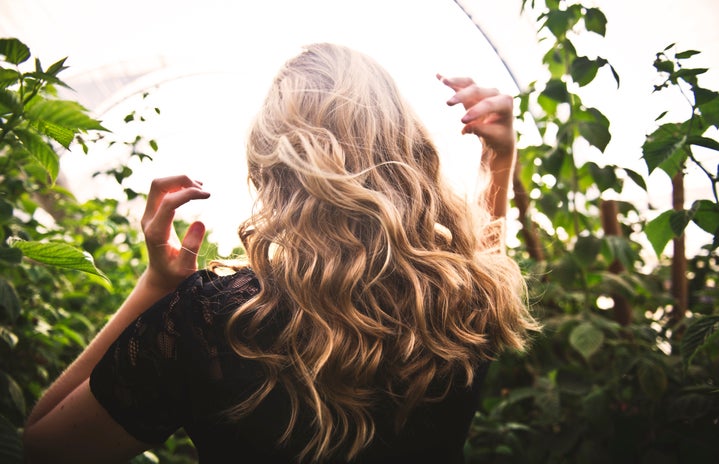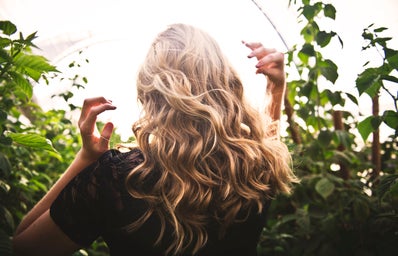This article is written by a student writer from the Her Campus at Chatham chapter.
To my friends who can’t think of a color their hair hasn’t been, I’m calling out to you. Taking care of heavily dyed hair is a challenge not many people know how to tackle. “Don’t use heat tools” is a great tip, but it’s not realistic if your hair isn’t the perfect child you’d like it to be. Our hair needs a lot more TLC than just “wash your hair every other day instead of every day” tips can cover. Mostly, it’s just a crapshoot. Here are some tips I’ve come to live by to avoid hair destruction.
1. Shampoo Only Your Roots
At first I didn’t understand why this was a helpful tip. Shampoo will still get on your ends, and you need it to anyway to keep away the grease bunnies. But when I see those shampoo commercials where women mash all of their hair on top of their heads and smush it all around like a pile of applesauce, it makes sense. The more you smush around your hair and agitate it, the faster your ends will split and the more angry your hair will become.
Instead of smushing, scrub your scalp like you normally would while your hair just hangs out by your shoulders. It will take some getting used to. Then, drag the soap froth through to the ends and rinse. It’s enough to keep the grease bunnies away, but not enough to hurt your ends in the process.
If it helps, think of your hair as a sentient person. Would you like being smushed around on some person’s head? Didn’t think so.
2. Condition the Bottom Half Only
Conversely, coating your scalp with conditioner is going to make your life harder. Conditioner is formulated to smooth your hair strands, not entertain your scalp while it suffocates under all the oils and acids. It’s actually better for your hair to leave the roots untouched while you focus conditioner on the ends.
Since the ends are the driest and the roots are the most nourished, this will also balance out the ‘look’ of your hair. Nobody likes it when the top half of your hair is behaving perfectly and the bottom half is going nuts with frizz and hair dye PTSD. You know exactly what I’m talking about.
3. Do the Final Rinse in Cold Water
I know, how dare I suggest you forego hot water and bathe in a stream of shivering demon water? Hear me out.
Your hair is like a straw, and inside the straw are the proteins that your hair dye is bonded to. Hot water makes your hair more porous and lets your dye leak. If you finish your shower with hot water, your hair strands never quite get sealed back up, leaving your wet hair liable to turn your white cotton pillowcase into a blue-green Rorschach test.
Supposedly, using cold water on your hair also helps it tame frizz, but at this point, we’re going to be balls of frizz and dryness no matter how much cold water we use.
4. Embrace All Things Oil
This is something I’ve learned by my own experience. Oil-based shampoos and conditioners are (personally) the kind that foster the best results in my hair. Oil helps restore what the hair dye removed: the shine, luster, strength, and moisture that virgin hair has.
Using oil whenever you can helps your hair maintain that healthy salon look instead of the I-got-this-dye-idea-from-a-WikiHow-tutorial look. You can layer it on throughout the day to keep the elements from causing problems too. Just be aware that oil serums specially made for hair are very slippery and go a long way. And don’t like to come off your hands.
When you’re actually dyeing your hair, put a thick, obscenely greasy layer of oil on your hair and let it sit for an hour or so before you apply the dye. Apply the dye right on top. It will provide a protective barrier for the dye so it doesn’t strip as much from what’s in your hair strand already. This is especially useful if you’re bleaching it.
Bottom line, oil is your best friend. If it comes down to Gina or your bottle of hair oil, pick your hair oil. Gina was kind of a jerk anyway.
5. Use Conditioner With Your Dye
Start with a big pile of white conditioner, a little more than what you would use on your entire head. (I know I’m going against what I said earlier about not doing that.) Then slowly add drops of concentrated dye such as Special Effects or Manic Panic, or even fancier brands I’m not familiar with because I’m broke. Keep adding color and stirring until your pile of white conditioner is a few shades darker than the color you’re going for.
You want to make the conditioner a few shades darker because your hair is actually incapable of soaking up every single bit of pigment, so your result will be lighter than the dye you’re mixing. Using white conditioner will also help you produce pastels, or mix your own unique blend of bottled colors. There’s also the fact that you will save a ton of money not using a whole bottle on your head each touch-up. There are so many benefits to mixing your own dye product. And, yes, it’s healthier than using straight dye.
6. Keep Trying Different Hair Products
I cannot stress this enough. You may have a favorite shampoo, but there may be one that is better and absolutely perfect for your hair. It even varies between brand. My hair knows the difference between Pantene Damage Detox with Mosa Mint Oil and Pantene Nature Fusion with Melon Essence. My hair knows, and it does not like Melon Essence. Your hair knows too. Because, again, hair is sentient here.
If you find a ridiculously good deal on a shampoo that your hair yearns to try, there is no reason not to try it. I got a bottle of Aussie (which is oil-based) for $1.50 so I tried it, and I love it. Remember to look for oils too!
7. Don’t Fall Into The Hype of “What’s Best”
Only you know how much you’ve done to your hair. You know exactly which shade of auburn you put on your hair and which portions of your hair have seen the most damage. The recipe for having healthy hair doesn’t lie in the all-knowing stylist or the preachy vlogger. Try different things, and take nothing as the gospel of hair care. As long as your hair doesn’t fall out in huge chunks and clog the drain every time you shower, you’re doing something right.

